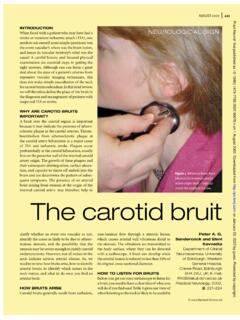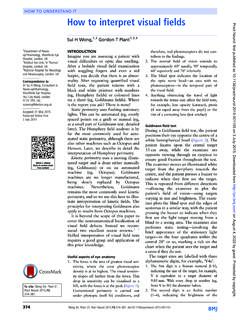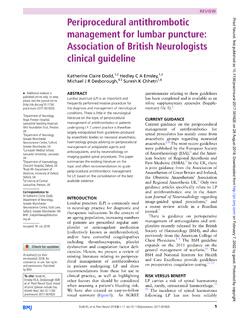Transcription of CLINICAL GUIDELINES Myasthenia gravis: Association of ...
1 Myasthenia gravis : Association ofBritish Neurologists managementguidelinesJon Sussman,1 Maria E Farrugia,2 Paul Maddison,3 Marguerite Hill,4M Isabel Leite,5 David Hilton-Jones5 Additional material ispublished online only. To viewplease visit the journal online( )1 Department of Neurology, greater ManchesterNeuroscience Centre, Salford, greater manchester , UK2 Institute of NeurologicalSciences, Southern GeneralHospital, Glasgow, UK3 Department of Neurology,Nottingham University HospitalsNHS Trust, Queens MedicalCentre,Nottingham,Nottinghamshire , UK4 Department of Neurology,Morriston Hospital, Swansea,Wales, UK5 Department of Neurology, JohnRadcliffe Hospital, Oxford, UKCorrespondence toDr Jon Sussman, Department ofNeurology, greater ManchesterNeuroscience Centre, Stott Lane,Salford, greater manchester ,M6 8HD, 13 April 2015To cite:Sussman J,Farrugia ME, Maddison P, ;15:199 gravis is an autoimmune disease ofthe neuromuscular junction for which manytherapies were developed before the era ofevidence based medicine.
2 The basic principles oftreatment are well known, however, patientscontinue to receive suboptimal treatment as aresult of which a Myasthenia gravis guidelinesgroup was established under the aegis of TheAssociation of British GUIDELINES attempt to steer a pathbetween evidence-based practice whereavailable, and established best practice whereevidence is unavailable. Where there isinsufficient evidence or a choice of options, theguidelines invite the clinician to seek the opinionof a Myasthenia expert. The GUIDELINES supportclinicians not just in using the right treatments inthe right order, but in optimising the use ofwell-known therapeutic agents. CLINICAL practicecan be audited against these GUIDELINES are designed to guidephysicians and general neurologists in themanagement of Myasthenia gravis . Theyare based on evidence where available,and on the experience of experts wherewell-established treatments lack is not possible to consider all thepotential decisions in managing myasthe-nia without resorting to opinion ratherthan GUIDELINES thereforedirect the physicians to seek the advice ofa neurologist with a specialist interest inmyasthenia where the evidence base istoo limited, where there is a range oftreatment options or when the disease isdifficult to gravis symptoms vary, andso patients should be managed as far aspossible by one clinician.
3 A myastheniaspecialist nurse or neuromuscular advisor,if available, should be involved in thecare of patients should receive the contactdetails of their named clinician in case ofclinical deterioration and should be awareof patient information literature availablefrom Myaware (previously the MyastheniaGravis Association ).iiThe UK Medicines and HealthcareProducts Regulatory Agency regularlyupdates its advice on the use of a rangeof medication. Please refer to contempor-aneous advice on the uses and interac-tions of the medications discussed inthese GUIDELINES can only offer sugges-tions on how to treat common clinicalscenarios. This document is intended tooffer guidance: it could be followed tothe letter or used flexibly. Individualswith Myasthenia vary, so it is assumedthat clinicians will select completed AGREE questionnairerelevant to these GUIDELINES is availableiThere are remarkably few studies comparingtreatments in Myasthenia gravis .
4 Some wereestablished before the era of evidence-basedmedicine. Some pivotal positive treatment studiesused only small numbers, and their flawed designmay account for studies suggesting that a commonlyused medication (mycophenolate mofetil) lacksefficacy. For these reasons, these GUIDELINES providepractical advice on starting standard treatment butavoid giving authority to non-evidence-basedopinion by suggesting that expert opinion is soughtwhere evidence is lacking, such as in the choice ofimmunosuppressive College Business Centre, Uttoxeter NewRoad, Derby, UK DE22 3WZ tel: +44 1332290219. Website at (accessed 23 Mar 2015).iiiThe same errors in Myasthenia management occurrepeatedly. These include a misplaced faith in thebenefits of pyridostigmine, and reluctance to usesufficient doses of prednisolone to GUIDELINESS ussman J, ;15:199 206.
5 On February 2, 2022 by guest. Protected by Neurol: first published as on 14 May 2015. Downloaded from on thePractical Neurologywebsite (see online supple-mentary appendix).INVESTIGATIONS, INITIAL ASSESSMENT ANDDIAGNOSISD iagnostic tests1. Serum anti-acetylcholine receptor (ACh-R) antibodytesting: first-line investigation for non-urgent Thyroid function: for all Serum anti-muscle-specific kinase (MuSK) antibodytesting: for all patients negative for ACh-R Neurophysiology: May help to establish the diagnosis inseronegative patients with suspected Myasthenia gravis . Itshould be performed by a practitioner with experienceof Myasthenia gravis . Repetitive nerve stimulation is theinitial test; if negative, consider single-fibre the testing on symptomatic MR scan of brain: Patients with negative serology andneurophysiology, and symptoms compatible with ocularmyasthenia may have structural brain Thymus scanning: All patients with suspected myasthe-nia, irrespective of distribution (ocular/generalised) orserology (seropositive/negative), should undergo thymusimaging.
6 The modality (CT or MRI) should be Referral to a Myasthenia specialist: If tests are negativeand Myasthenia is still suspected or if a congenital myas-thenia syndrome is Edrophonium/Tensilon test. If there is diagnostic doubt,refer to a Myasthenia gravis of diagnosis and subtypeACh-R/MuSK seropositive/seronegativeThymoma/no thymomaviiOcularviii/generalisedCongenit al:(maymimicseronegativeautoimmunemyasth enia)Possible Myasthenia but tests negative: consider a muscledisorder or refer to Myasthenia expert for TREATMENT PLAN Choose inpatient care: For significant bulbar symptomsearly on, low vital capacity, respiratory symptoms or pro-gressive deterioration. Choose outpatient care: For ocular symptoms, mild-to-moderate limb weakness and mild bulbar symptoms. Ocular Myasthenia gravis : See section Treatment ofocular Myasthenia gravis . Generalised Myasthenia gravis : See section Treatment ofgeneralised Myasthenia gravis .
7 TREATMENT OF OCULAR MYASTHENIAGRAVISix xStarting treatment for ocular Myasthenia gravisxi1. Start pyridostigmine following protocol. See section Pyridostigmine dose escalation protocol .2. If the serum ACh-R antibody is positive and the patientis aged under 45 years: consider thymectomy xiii3. If symptomatic despite pyridostigmine, start prednisol-one (generally given on alternate days)xivSee section Protocol for starting prednisolone for outpatients withocular Myasthenia gravis .4. If symptoms relapse on prednisolone withdrawal at adose of 10 mg/day (or 15 20 mg alternate days) orgreater, consider sections Patients who do not achieve remission with prednisol-one and Immunosuppression .ivOther autoimmune diseases are more common in patients withmyasthenia gravis ; thyroid dysfunction that may otherwise be occultmay exacerbate Myasthenia . B12deficiency is more common inpatients with Myasthenia gravis and may cause changes in the fullblood count, including a rising mean corpuscular volume andfalling white count (mimicking the effect of azathioprine).
8 Forpractical management of Myasthenia gravis , measuring B12can electromyography lacks specificity. It helps in theclinical setting of Myasthenia but may be positive in a wide range ofother settings, such as denervation and myopathic disorders. Itshould therefore be carried out only by neurophysiologists withexperience in neuromuscular transmission edrophonium test may be difficult to interpret. Conditionsthat mimic Myasthenia may produce a positive result and there arepotential cardiac complications. If serology and neurophysiologystill give no diagnosis, seek a specialist hyperplasia is a pathological diagnosis and cannot beevaluated by scanning. The scan is done solely to exclude that most patients with ocular Myasthenia developgeneralised Myasthenia within about two recently published EFNS/ENS Guidelines3offer is little evidence for the pyridostigmine and prednisolonedose schedules recommended here; there are no studies comparingtreatment regimens.
9 These GUIDELINES are based on the practice ofexperts in the field. The emphasis is on identifying the optimumdose for each patient. Undertreatment, particularly withcorticosteroids, is the commonest cause of persisting 50% of patients with ocular Myasthenia developgeneralised Myasthenia within 2 years and up to 75% do so within3 years or so of disease onset. This is more likely in the experts consider thymectomy, and particularly the lesstraumatic and scar-minimising video-assisted thoracoscopicthymectomy in a young person with seropositive generalisedmyasthenia gravis . Some experts consider video-assistedthoracoscopic thymectomy in purely ocular Myasthenia is probably most effective if carried out early on, say2 years after symptom onset. Thymectomy probably does not helpestablished ocular Myasthenia gravis where there is little risk video-assisted thoracoscopic thymectomy even beforestarting corticosteroids may be an option for some patients.
10 Asthymectomy produces benefit slowly, this is appropriate only forpatients with mild alternate day corticosteroid regimen probably reduces sideeffects. Daily corticosteroids may be suitable in some patients, suchas those with diabetes principle, immunosuppression is only started following relapseinduced by corticosteroid withdrawal. In some patients withcomplex medical problems, higher doses of corticosteroids may bepreferable to immunosuppression, or vice versa. It is impossible toprovide absolute guidance on the target corticosteroid dose. Insome patients, even low-dose corticosteroids cause side effects;these might be treated with immunosuppression. Exceptional casesshould be discussed with a Myasthenia GUIDELINES200 Sussman J, ;15:199 206. on February 2, 2022 by guest. Protected by Neurol: first published as on 14 May 2015. Downloaded from Pyridostigmine dose escalation protocolxvia,xvibTitrate up to find the lowest effective dose: Initially 30 mg ( tablet) four times daily for2 4days.






